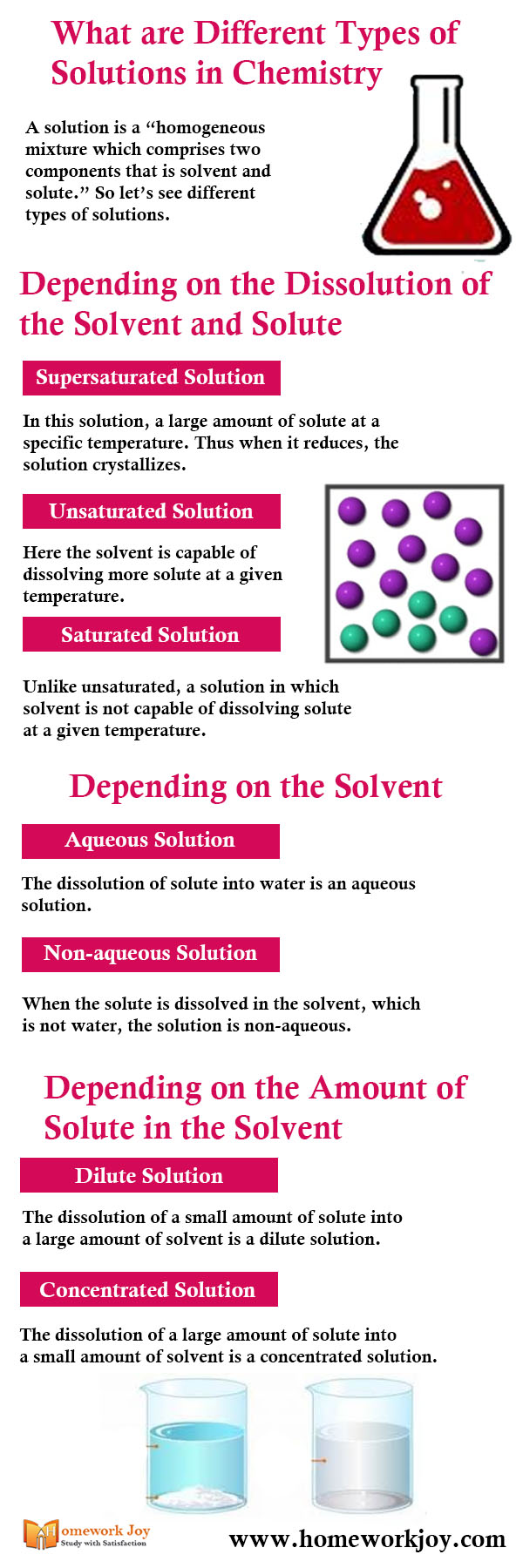There are different types of solutions in chemistry. Like, have you ever made a lemonade? Well, that is also a solution in chemistry. Since sugar and lemon are the solutes and water is the solvent, together they form a solution called lemonade.
Don’t get confused with the terms – solvent, solute, and solution. Let’s discuss them in detail. But before that, also see some latest posts by us.
What is Chemical Bonding | Types of Chemical Bonding
6 Types of Reaction in Chemistry With Examples
A solution is a “homogeneous mixture which comprises of two components that is solvent and solute.” In a solution, a solvent dissolves solute in it to compose a solution. So let’s see different types of solutions with examples one by one.
Depending on the Dissolution of the Solvent and Solute
Supersaturated Solution
In this solution, a large amount of solute at a specific temperature. Thus when it reduces, the solution crystallizes.
For example, when 2.5g of CuSO4 is mixed with 10g of H2O at 20 degrees Celsius, it forms crystals.
Unsaturated Solution
Here the solvent is capable of dissolving more solute at a given temperature.
For example, iced coffee or tea that you make is an example of an unsaturated solution. As the solution contains more amount of sugar, it is a perfect example of an unsaturated solution. Besides this, air, mist, smoke is examples of unsaturated gaseous solution.
Saturated Solution
Unlike unsaturated, a solution in which solvent is not capable of dissolving solute at a given temperature. There are some factors which affect the dissolving power of solute in the solvent:
- Temperature: when the temperature increases, the solubility also increases.
- Pressure: if the pressure increases, the solute becomes more soluble into the solvent.
For example, a soda is a saturated solution of carbon dioxide in water.
Depending on the Amount of Solute in the Solvent
Dilute Solution
The dissolution of a small amount of solute into a large amount of solvent is a dilute solution. It can be any solution in which solvent is in large amount as compared to the solute.
For examples, pure lemon juice in water is the example of a dilute solution.
Concentrated Solution
The dissolution of a large amount of solute into a small amount of solvent is a concentrated solution.
For example, lead-acid batteries with more amount of sulphuric acid is an example of concentrated acid.
Depending on the Solvent
Aqueous Solution
The dissolution of solute into water is an aqueous solution. It can be any solute that dissolves in water.
For example, the dissolution of table salt in water or mixing of ethanol in water is an example of an aqueous solution.
Non-aqueous Solution
When the solute is dissolved in the solvent, which is not water, the solution is non-aqueous.
For example, a brass solution is an example of a non-aqueous solution. A brass solution is the dissolution of copper into zinc.
So it was a lesson on different types of solutions in chemistry. Moreover, to know more about similar topics or to order assignment on the above topic, get instant chemistry assignment help from our experts.
